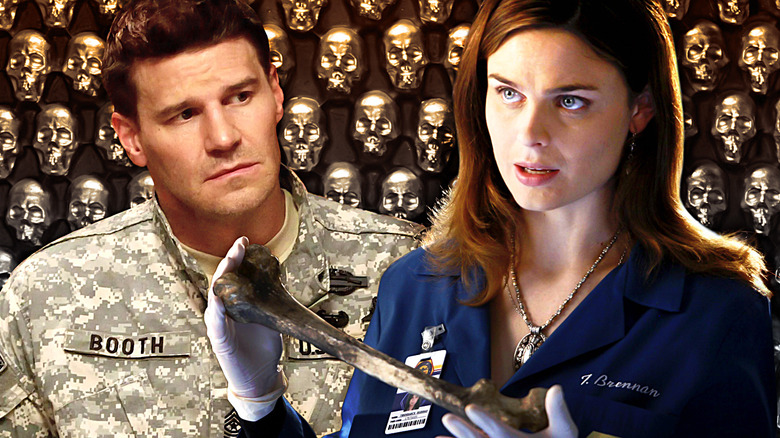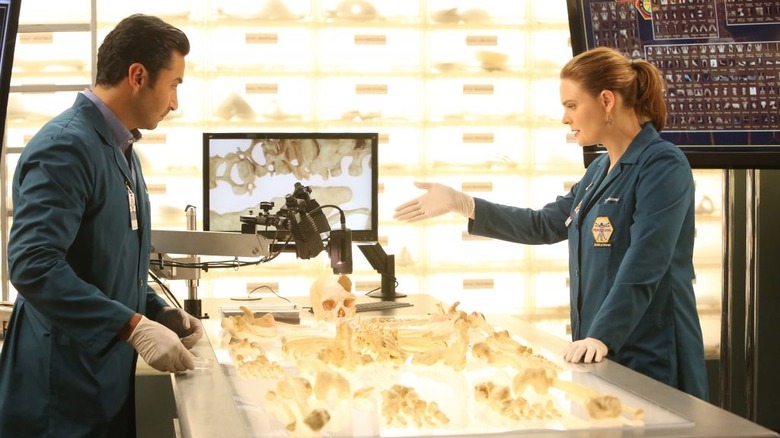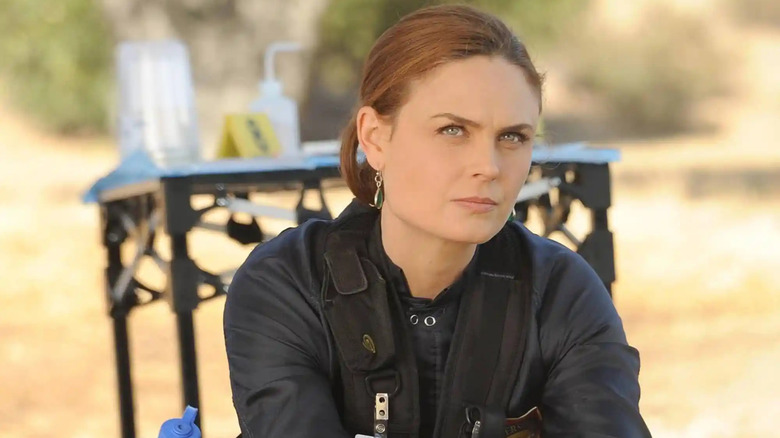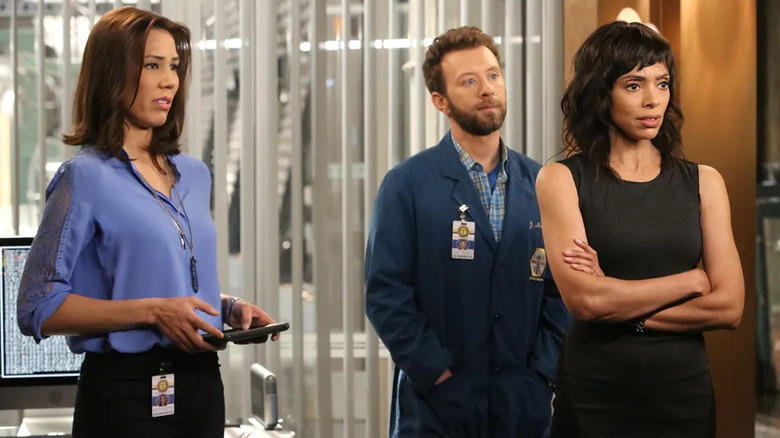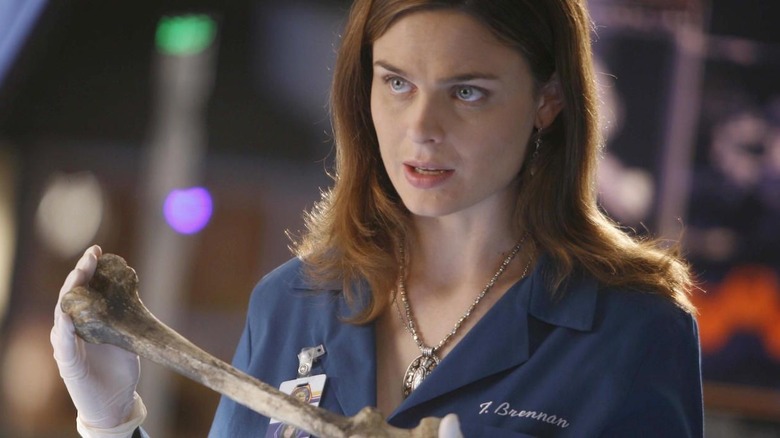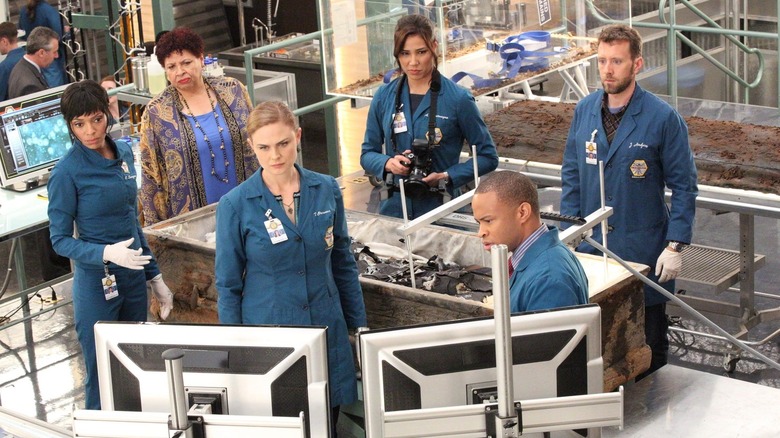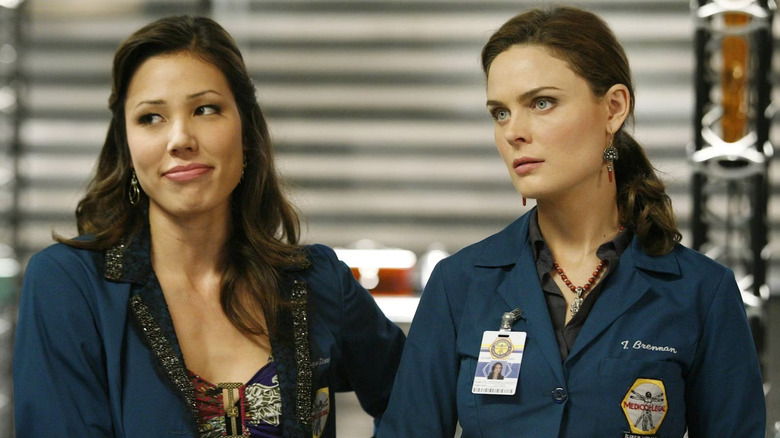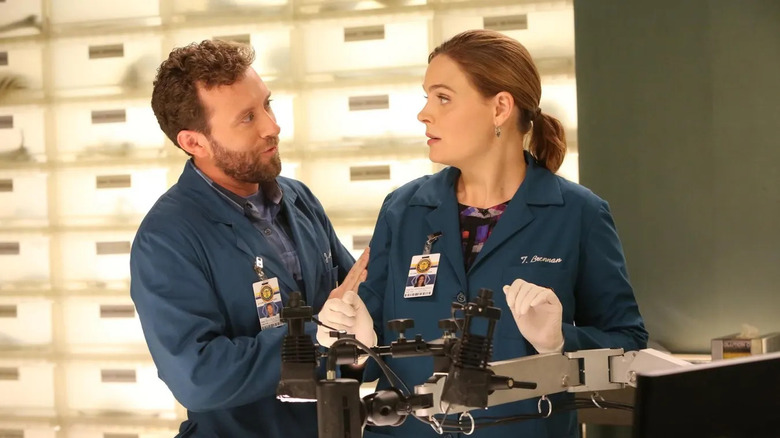8 Things About Fox's Bones That Make No Sense
Not every TV show or movie ages gracefully, and to some extent, that's fine; some art is a product of its time, and while the ideas and goals of that art might be admirable, sometimes societal changes will lead to the re-evaluation of the work. Sometimes, a TV show or movie just has stuff that's not necessarily offensive, but just doesn't make any sense. That definitely applies to the Fox procedural "Bones," which came to an end in 2017 after twelve seasons.
"Bones" is, as I just said, a procedural — and anyone who's watched, say, "Law & Order: Special Victims Unit" or "NCIS" or any other popular show in that genre knows they all take some liberties with reality. They sort of have to; a real forensic anthropologist — the occupation of "Bones" leading lady Temperance Brennan, played by Emily Deschanel — probably doesn't encounter quite as much intrigue as "Bones" would have you believe. So what are some things that still don't make sense about "Bones," a show that centers around Brennan, her FBI counterpart and eventual husband Seeley Booth (David Boreanaz), and the work done at the fictional Jeffersonian Institute to investigate cold cases? Here are just a few (fairly egregious) examples.
The storage at the Jeffersonian is straight-up bizarre
TV shows get the opportunity to make certain professions look way more glamorous and exciting than they are (just as an example, we hope that doctors don't spend as much time hooking up in on-call rooms as they do on, say, "Grey's Anatomy"). "Bones" is guilty of this too, particularly when it comes to one specific aspect of the Jeffersonian: the way they store the bones they study.
Now, I'm not a doctor. I'm not a forensic anthropologist. It still seems, to me, that storing human bones in light-up cabinets that look like they belong in an Ikea showroom might not be the best way to preserve the integrity of the specimens. Still, this is the decor at the Jeffersonian, and throughout the series, you can see individual bones or piles of bones tucked away in well-lit boxes that line the institution's walls. It's jarringly weird to see, and nobody ever says a word about it, even though Temperance Brennan is definitely a stickler regarding how things are run around the Jeffersonian.
Temperance has a side hustle, somehow
All in all, Temperance "Bones" Brennan seems pretty busy from day to day. If she's not traveling directly to crime scenes with Seeley Booth or narrowly escaping near-death situations (more on those shortly), she's ... asleep, probably. There are only so many hours in a day. So here's another thing I don't totally understand about Temperance: how does she possibly find time to write crime novels as a side hustle?
Not only does Temperance write crime novels, she's very successful at it; in a season 2 episode, it's revealed that she's a New York Times-bestselling author. There's a real reason behind this particular weird thing, which is that Temperance "Bones" Brennan is a character created by real-life crime novelist Kathy Reichs, who served as a producer on the show (and wrote a handful of episodes) after the success of her own series about Bones. Still, this doesn't explain why or how the on-screen version of Bones finds the time to outline her novels, actually sit down and write them, presumably participate in press tours occasionally, and become a nationally (internationally?) successful author. It's a nice detail as an homage to Reichs, but it's completely silly if you think about it for more than five minutes.
How do the scientists on Bones identify victims by their race?
A strange things happens more or less constantly on "Bones" where, as the team at the Jeffersonian try to get more information about a victim using only their bones, they sometimes declare that said victim is definitely from a specific racial background. This, according to a 2015 report in Buzzfeed News, is utter nonsense; you can't actually be completely sure of anyone's race just from looking at their skull, despite Temperance Brennan's insistence that a victim is Caucasian (or whatever she declares in the moment).
The outlet spoke to Dr. Elizabeth Miller, an anthropology professor and consulting anthropologist who worked with the Los Angeles Police Department at the time, and she said that Brennan's identification methods are oversimplified at best and absurd at worst, basically. "I usually say something like 'white,' which includes a long list, and then as a caveat, I put, 'This bears no relationship to the race an individual considers themselves, and has no bearing on hair color or skin type,'" Miller said before also saying that it's incredibly difficult to pin down a victim's race just from their skeletal remains. "It's the hardest thing to determine, it is the least accurate, and I'm never surprised when I'm wrong," she continued. "Pardon the pun: It's not a black-and-white issue." Yes, this is also something that can be chalked up to TV magic, but it's still really silly.
Temperance Brennan apparently lives under a rock
Temperance Brennan's whole deal is that, even though she's a best-selling author and a brilliant forensic anthropologist, she doesn't seem to know anything about, say, pop culture. This gets exaggerated to the point where one of Temperance's catchphrases is literally "I don't know what that means," which she says basically any time any other character makes a reference to movies or TV shows. (This happens twice, actually, when other characters name-check Fox Mulder and Dana Scully, the lead characters from "The X-Files" played by David Duchovny and Gillian Anderson, just as one example).
Not everyone is as up-to-date on their pop culture references, and even as someone who mostly speaks in fragmented "30 Rock" quotes, I'm well aware of this fact. Still, Temperance lives in the same world as the other characters, yet in season 2, she doesn't know who Michael Jackson is. Yes, that Michael Jackson. The world-famous pop-star. The guy who made "Thriller." Seriously? It doesn't seem like Temperance lives on the same planet as her on-screen counterparts, which also puts her status as a popular novelist back into question.
The forensic science on Bones moves defies the space-time continuum
This is probably a really common complaint about procedurals — again, they have to make certain changes in order to make the featured look a little cooler than they really are — but the timeline on "Bones" is seriously wonky in terms of the science depicted on the show. The bottom line is that all of the DNA analysis and other forensics needed to actually learn about these victims takes a while. Again, I'm not an expert in all of this, personally. I write about movies and TV. I have to assume, though, that real forensic anthropologists can't determine information about cold cases in a matter of minutes, like the team does all the time on "Bones."
"Bones" would also be a really boring drag if everything took the correct amount of time, so this is sort of a small nitpick. Still, if you consider how long things would actually take, it could take you out of the universe just a little bit.
Literally everything Angela does on Bones is nonsense
At the beginning of "Bones," the quirky, offbeat character Angela Montenegro — played by Michaela Conlin — is basically an elevated sketch artist, who's able to look at, say, a skull and approximate a drawing of what the victim might have looked like before they died. It's also mentioned that she earned an undergraduate degree in computer science, but none of this really explains two machines seen on the show, both of which perform functions I have to imagine doesn't exist in most forensic anthropology labs.
First is "the Angelanator," which projects holographic images of what the victims could have looked like and creates 3D scenarios explaining how said victims could have possibly died. This apparently isn't high-tech enough for Angela and her team, because they eventually upgrade to the "Angelatron," which moves the images to flat-screen displays (a change that was, in all likelihood, easier on the show's visual effects budget). The Angelatron gets blown up at the end of the series (spoiler alert), but the fact that it existed in the first place feels patently absurd.
Seeley Booth's lineage can't possibly be correct
At several different points throughout "Bones," the significance of Seeley Booth's last name comes up — because the show insists that he's a direct descendent of John Wilkes Booth, the actor, Confederate spy, and assassin who killed President Abraham Lincoln in 1865. This is a funny little Easter egg for the series to include, but there's one major problem here. John Wilkes Booth doesn't, by all accounts, have any direct descendents.
Much is known about the historical Booth's family — he came from a family of ten children and a long line of actors — but there's zero evidence that he was married or ever had children, which would make it impossible for "Bones" lead Seeley Booth to be a direct descendent of the famous murderer. Sure, maybe Seeley is descended from one of John Wilkes Booth's siblings, but that's not what the show said; it says he's a descendant of the gunman himself. Cute idea, but the execution is a little lacking here considering that you can just Google whether or not John Wilkes Booth had kids before he was shot and killed the same year he shot the 16th President.
Why are people always trying to kill the scientists at the Jeffersonian?
There's no question that the team at the fictional Jeffersonian Institute — which stands in for the real Smithsonian — is a brilliant bunch. That doesn't quite explain why everyone is trying to kill them all the time. Whether it's serial killers like the Gormogon or The Gravedigger — the latter of whom traps Temperance Brennan and T.J. Thyne's Jack Hodgins in a car buried underground and leaves them to die — or just people flat-out bombing the Jeffersonian, the show never adequately explains why the team is always in such an insane amount of danger. It also doesn't really explain why Dr. Zack Addy, played by Eric Millegan, infiltrates the Jeffersonian as Temperance's assistant while working for the Gormogon. What was he trying to accomplish? Did the serial killer really want the fantastical Angelanator machine or something?!
Yes, this is clearly an attempt to inject a ton of dramatic tension into the series, but at a certain point, you have to wonder why Temperance, Seeley Booth, and all the rest are constant targets of attacks; the bombing of the institute even happens at the very end of the series, lest the audience get too comfortable about the fate of their favorite characters. A bunch of forensics experts probably wouldn't be constantly chased by killers, but it does make for fun television.
"Bones" is streaming on Hulu now.
